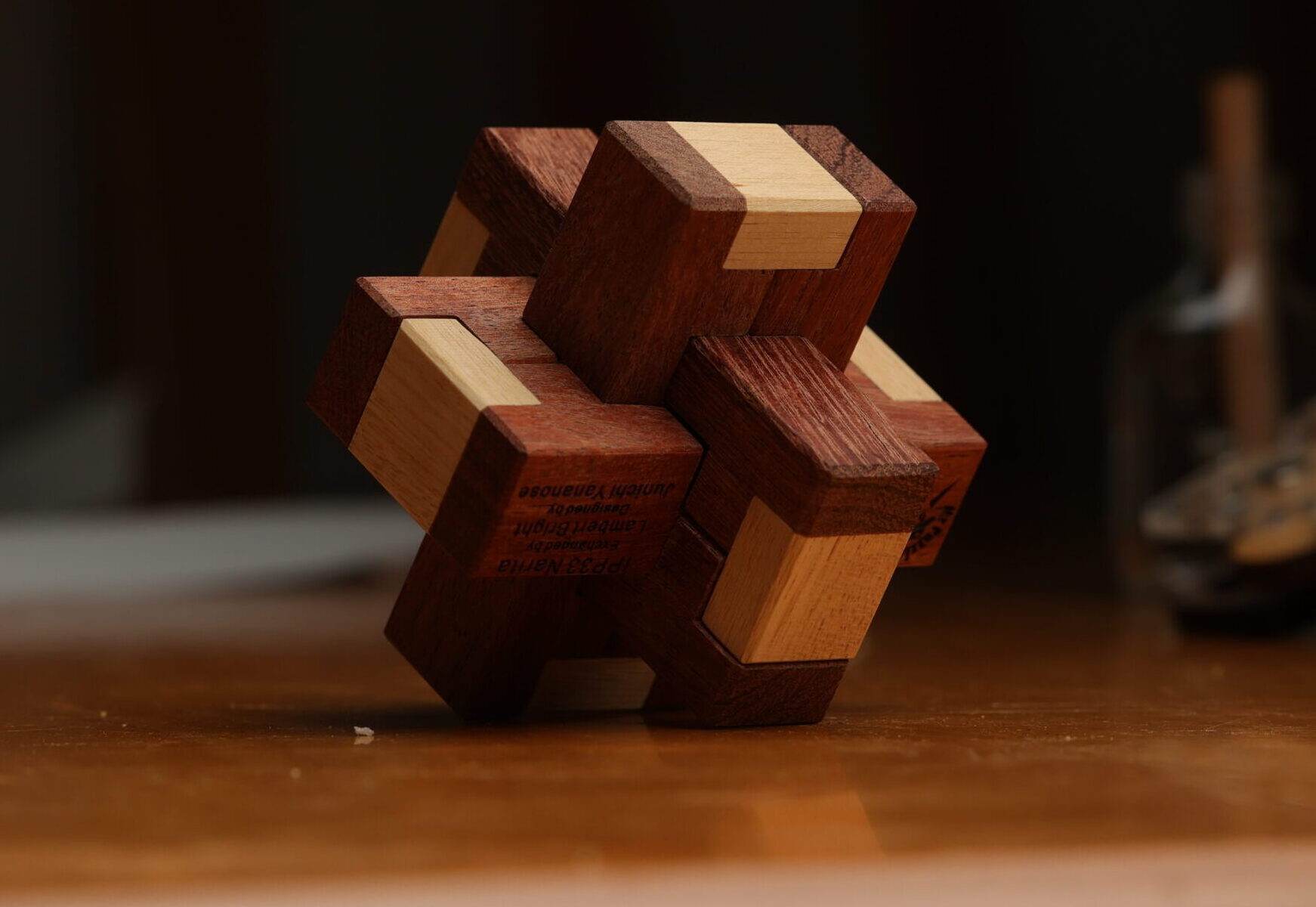“The definition of insanity is doing the same thing over and over and expecting different results”
-Albert Einstein
When Einstein said this quote, it might be he was referring to Interlocking puzzles.
With them you might be trying the same things again and again, and without noticing – you’ll become insane.
But becoming insane will not help you solve Interlocking puzzles.
To succesffully disassemble and reassemble them, you’ll need :
High levels of spatial thinking;
Vivid imagination;
Deduction skills;
Patience and motivation;
In extreme cases, a BurrTools file (more on that later).
Luckily, most of these skills can be improved by solving easier interlocking puzzles. As always, jumping outright into the highest difficulty is not recommended, unless you want to go insane. The Einstein way.
Quick Navigation
Interlocking Madness
One of the classic types of puzzles. It had gone through lots of development.
Interlocking puzzles have become extremely refined and elegant, especially by the hands of master craftsmen like Jakub Dvorak, Eric Fuller, Brian Young and many more.
Numerous Pieces – Interlocking puzzles consist of a number of pieces that can be similiar to or different from each other. The number varies – It could be anywhere from 3 to 50+.
Interlocking – As the name implies, the pieces are designed in a specific way that allows them to lock each other at the assembled state. When locked this way, there’s usually only one move you can do that unlocks more moves.
Moves – Most interlocking puzzles’ solutions consist only of linear moves. Rotations are used sometimes as well, but they’re much less common. When more than one pieces move to the same direction and length, it’s considered as one move.
Solution Level – When I say a Hanayama is a level 5, I mean that it’s 5 out of 6 in the difficulty scale. When talking about interlocking puzzles, level 5 means that it takes 5 moves to remove the first piece. A level 5.4.2.2 puzzle means it takes 5 moves to take the first piece, then 4 moves for the second, and so on.
Traps – Tricky designs will give you more than one option for a move. Doing a sequence of incorrect moves will trap you at a dead end. On this occasion you’ll have no choice but to back-track some, or many moves.
Themes – Something that I like in particular in the interlocking group is themed puzzles – functionally they are the similar, but they are designed to look like animals, objects or even vehicles. Beautiful!
Sent Disassembled – Interlocking puzzles are usually sent assembled. But – sometimes, to increase the challenge, they are being sent disassembled! You won’t have any idea of the first and last moves or what is the intended place of the pieces. This will happen if it’s considered more fun to solve it this way – and that means it’s possible to do it, even if it’s harder than normal.
The puzzle at the top is called Stepping Burr, designed by Junichi Yananose and made by Brian Young (picture by Bar Aharon). There’s also an Eric Fuller version.
The Stepping Burr has a level 10 solution, consists of 6 pieces, and is considered tricky – especially so since Young’s version was sent disassembled.
Check out my mini-review of it on Puzzle Wanderer’s Instagram page!
Pieces of the Puzzle Type
Interlocking puzzles come in different ways, and albeit they have more similarities as opposed to other puzzle types like Combination or Take-Apart, they too have their own unique traits.
Burrs
The ancient interlocking puzzle type, from which this whole interlocking family began.
Said to be first seen on an engraving from 1698, the burrs have started as a 6 stick-shaped pieces symmetrical construction. The assembled shape was similar to Stepping Burr’s.
Each stick had square (right-angled) notches of it cut at the middle in such manner that allowed all 6 pieces to interlock. The movements were linear.
From there burrs have developed into more intricate designs, like pagodas or chucks, their shape more complex, or knot burrs that consist of rectangle-shaped pieces.
Classic burrs in their assembled state are symmetrical, unlike modern burrs – they have their own rules.
Understanding the original burr designs will help you understand their modern, evolved versions, as they’re based on the same concept of moving pieces in a certain order until you disassemble everything.
This is where you’ll learn that assembly is much harder than disassembly. The pieces look generally alike and imagining their assembled position is very challenging.
It’s also important to note that the puzzles that evolved from burrs are usually referred to as Interlocking puzzles in general.
The best value for money for classic burrs is without doubt a burr set. Keep an eye on these – variations of them get released every now and then.
Caged Burrs
Like in a normal burr puzzle, in a caged burr puzzle you will have a constrcution of interlocking pieces to disassemble and assemble.
The difference though, is that in addition to normal pieces you have a cage piece/s.
The caged piece/s are a serious obstacle and tend to make things much more complicated, as all pieces must interact together while moving within a shared cage.
This cage can block many movements, but not swear words – those will come flowing from your mouth increasingly.
Conceptually similar to caged puzzles are surrounding burrs – burrs that hide or lock some kind of piece inside, like the recent Alligator puzzle by the notorious Stephan Baumegger, beautifully made by Pelikan (was sold out pretty fast on their site, and at the moment is only available at other stores). It has a small alligator-themed piece inside that interacts with other pieces, increasing complexity.
A Note on BurrTools
Before moving on to more Interlocking style puzzles, I want to elaborate on one nuance you should be familiar with.
Some burrs, especially high level or high piece-count ones, are painfully, extremely, agonizingly, HARD to assemble. Close to impossible by humans.
I’m not kidding.
Some high level burrs you will be able to disassemble, but going through assembly will prove to be too hard to be fun. And this is not something to be ashamed about.
One way to bypass this issue is to somehow mark the place where the each piece was at the start – best way to do it is with colored stickers. You can then draw on a paper where each color was.
This trick will save you countless hours looking for the correct piece arragement.
Another way is BurrTools, a program for interlocking puzzles analysis. Download the program, then find the BurrTools file for your puzzle. This is easy to do in the Mechanical Puzzle Discord – just ask for the file for your puzzle in the BurrTools thread, and a friendly puzzler will send it. If you prefer, you can also contact me and I’ll get the file for you.
I won’t go into detail about how to use the program in this post – but it’s not too difficult to figure out. What you need to do is to run the file there and it’ll show you a complete, step-by-step solution of the puzzle. If you don’t want to see the assembly, you can check where each piece ends up being instead.
Always remember that puzzles should be fun. The challenge of solving them is great as long as it’s humanly possible.
In all other puzzle types I would humbly advise to abstain from solutions.
More Types!
Coordinated Motion
Perhaps the most friendly Interlocking puzzle type out there.
Or is it?
This daughter-in-law of burr puzzles is the artful incarnation of an elegant motion – in which all pieces steadily move away from the center until reaching a certain tipping – point, where they all fall apart together.
While not as complex as burrs, they are astonishingly satisfying, and may be tricky to reassemble. Understanding their internal workings may prove to be very difficult, and they will require large amounts of dexterity to execute assembly.
A great, budget friendly manufacturer specializing in coordinated motion puzzles is Vin&Co. His puzzles are precisely made and deeply inspired by the legendary designer Stewart Coffin.
Themed
If interlocking puzzles were a country, themed puzzles were the capital.
I consider them the top-notch interlocking puzzle designs, aesthetics-wise – and luckily a theme can be applied to all interlocking puzzle types.
Themed interlocking puzzles are creatively designed to resemble a certain object.
Which is, in fact, their biggest advantage. Assembling an interlocking themed puzzle is a fun process, as you can understand the original placement of the pieces once disassembled. The goal remains putting the pieces together.
But don’t be fooled. Sometimes these burrs can be so devilishly hard that you’ll need to use BurrTools as well – especially the high level ones.
With noticably less trial and error needed, you will use a bigger part of your thinking to understand the interactions between the pieces – making the themed interlocking puzzle the purest spatial thinking challenge.
Verdict
One of the oldest puzzle types has had much time to evolve.
And the results are up front. For someone newly interested in mechanical puzzles, one of most important puzzle types to try is Interlocking puzzles.
Appreciated and solved by many, they provide both complexity and elegance. A must try for every puzzler.
Despite being widely appreciated, I can’t say it’s the most popular puzzle type – but still a very important type to understand. Many advanced puzzles use interlocking mechanisms as a part of the solution – knowing the basics will prove useful.
Important tip – start with low-level (you know the term!) interlocking puzzles, preferably classic 6-piece burrs, then build your way up. Before you know it you’ll be much more experienced and ready for mindblowing challenges.
Have fun!




